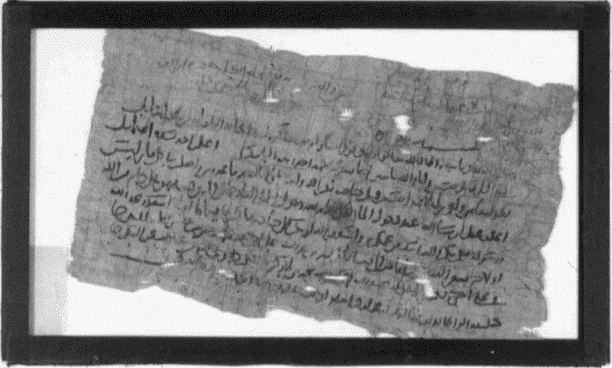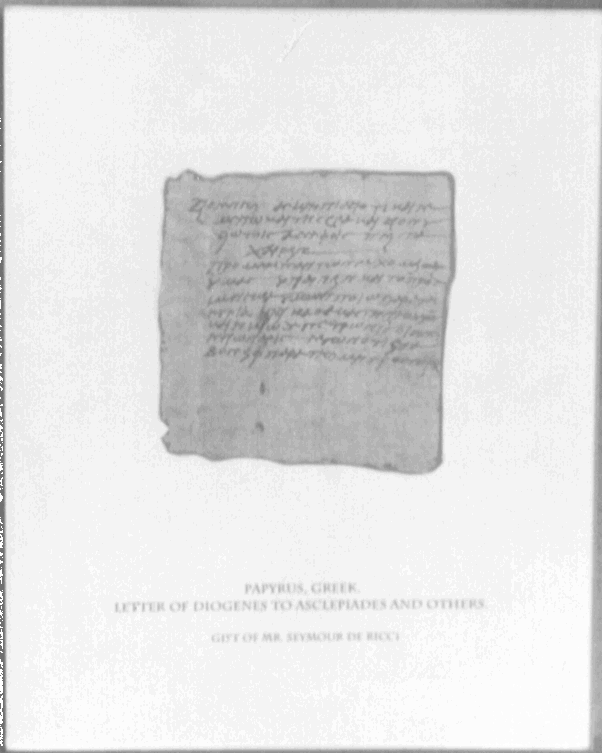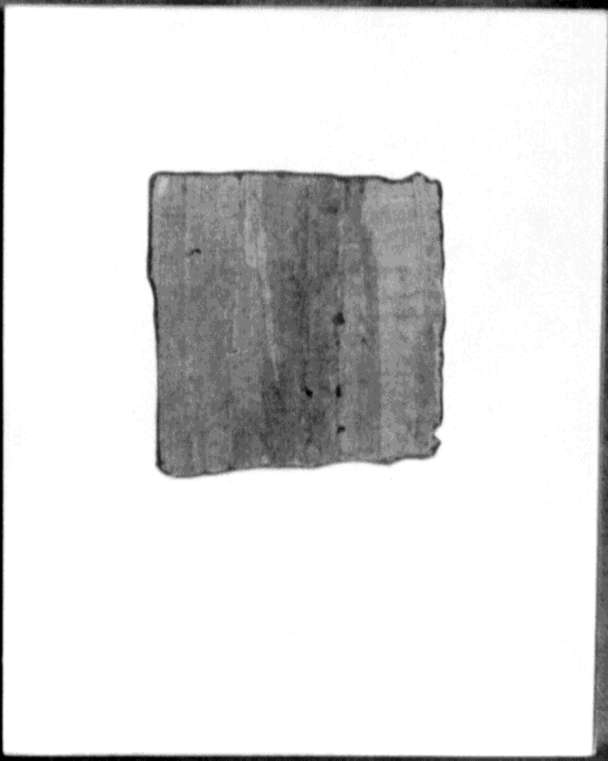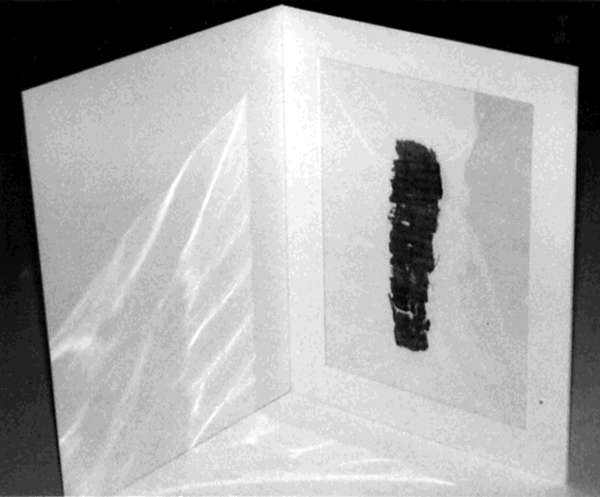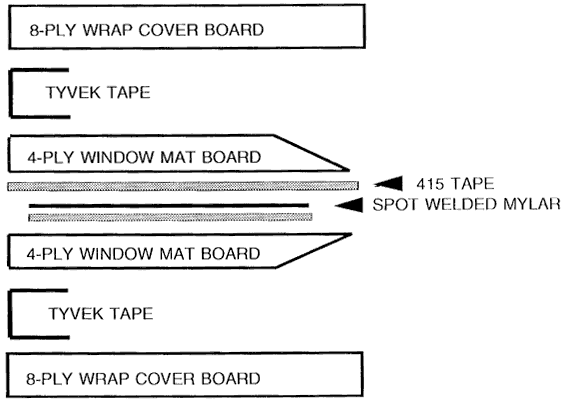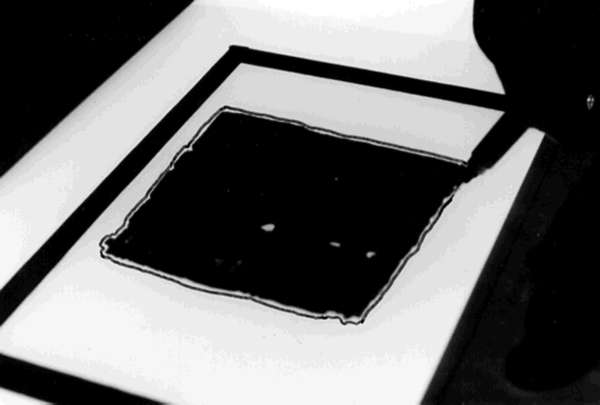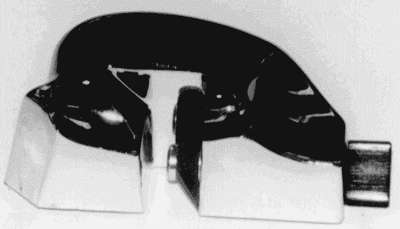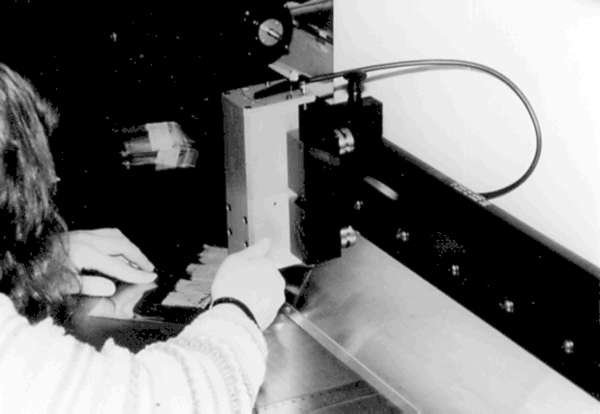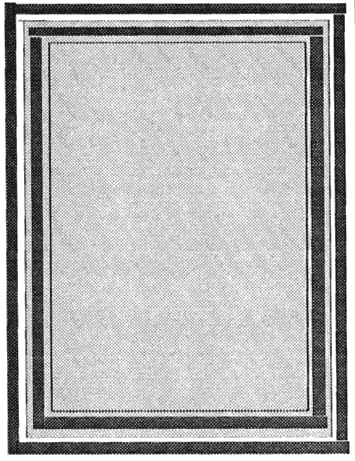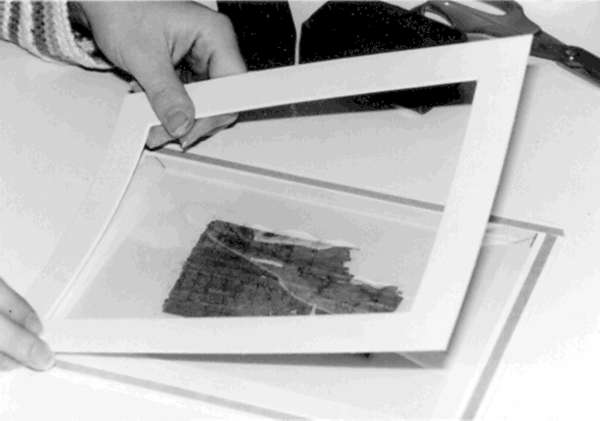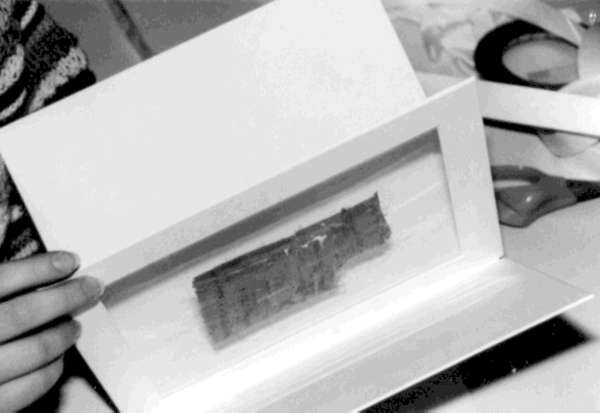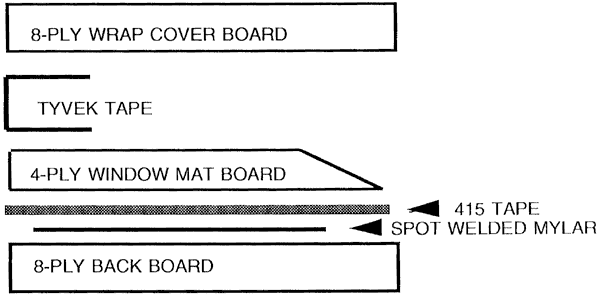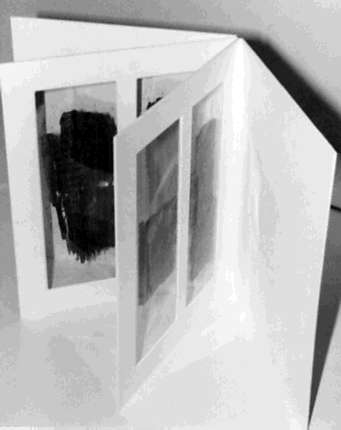Papyrus Storage at Princeton University
by Ted StanleyIntroduction
Papyrus artifacts such as fragments and rolls are a part of many collections in libraries and museums around the world. The vast majority of papyrus collections are still stored in traditional glass plate sandwich housings (fig. 1). The traditional system of storage as well as some other methods may adversely affect the preservation of papyrus artifacts. This paper introduces a sound system of storage for both small and large papyrus collections.
Fig. 1. Papyrus fragment in a traditional glass
sandwich housing
Brief Historical Background of Papyrus
Papyrus is a Latin word from which the word paper is derived. Papyrus is not true paper in the sense that sheets are not formed from macerated fibers. The use of papyrus as a writing material goes back several thousands of years. It was once the most widely used writing surface in the world. The papyrus plant is a giant sedge, Cyperus papyrus, which is native to the Nile region. Sheets of papyrus were formed by slicing the pith of the plant and laying very thin strips in a row with the edges slightly overlapping. Another row was laid at a right angle on top of the first layer. The layers were moistened with water and pounded into a sheet with a hammer. The sheet was then pressed and dried. A flour (Egyptian), water and vinegar solution was used as a sizing (Hunter 1978, 21).
Sheets were usually sold in long rolls or bales. The rolls were formed by attaching the sheets end to end with what is thought to have been a starch adhesive. Individual sheets could then be cut off the roll as needed. Individual sheets were between 7 and 20 inches long. Each roll had about 20 sheets of papyrus. The better grades of papyrus were more brownish in color. The best quality sheets were made from slices that came from the heart of the plant. When a sheet of papyrus was written upon, the side with the horizontal layers was normally used.
Papyrus was an expensive material because its production and sale were controlled by royal monopoly. This made its trade a lucrative market. At one time or another the Egyptians, Greeks, Romans and Byzantines held state monopolies in papyrus trade. Papyrus saw its greatest use between the 4th century A.D. and the 4th century B.C. As the technology of papermaking spread, however, paper eventually replaced papyrus as the predominant writing material.
The Dangers of Traditional Storage Methods
During the 19th and 20th centuries papyrus artifact collections appeared in many museums and libraries in Europe and the United States. The traditional manner to house papyrus artifacts, such as manuscript fragments, was to place them between two pieces of glass and seal the edges with cloth tape. There are several disadvantages to this method of storage. The artifact can be dropped and damaged. The artifact is also in direct contact with the surface of the glass, which may cause heat and moisture to be conducted to the artifact. Such a condition may cause the surface of the papyrus to become adhered to the glass. The surface of the artifact and the inks may be damaged when the glass is removed. What little hydroscopic properties (expansion/contraction) that the fragile artifact has left may be restricted by the pressure of the glass enclosure.
In addition, a grayish material has been noticed in many instances inside of the glass sandwich around the edges of the artifact. Work by Banik and Stachelberger (1978) has identified the substance as a composite of mostly sodium chloride and traces of vegetable carbohydrates. It is theorized that the sodium chloride comes from the papyrus itself. The salt is thought to come from the salt rich earth in which the papyrus artifacts were buried. Their research eliminated biological infestation as a cause of the deposits.
Other types of mounting systems using cellulose nitrate, paper backings, drumming techniques, hinges and adhesive mounts, dry mount systems and Plexiglas pressed directly against the artifact are also undesirable. These housing techniques are problematic in that they are not easily reversible, introduce materials that may stain the artifact, may degrade the artifact or place undue pressure against the artifact.
The Papyrus Collection at Princeton University
Description of the Collection
The Rare Book and Special Collections Department of Firestone Library houses a large collection of papyrus artifacts that is used by both students and scholars. The collection contains approximately 700 to 1,000 pieces in the form of fragments and rolls. The materials in the collection date between 332 B.C. and 650 A.D. Materials include Greek census and tax registers, petitions, business records and items of historical and paleographic interest written in Egypt. Other materials include 30 literary fragments attributed to Euripides, Homer, Isocrates and others. Several important Bibles are also in the collection.
Condition of the Collection
Most of the papyrus artifacts in the collection are stored in traditional glass sandwich housing units. Some artifacts are stored in folders between sheets of paper. Others are encapsulated in polyester film and hinged to a board. Some papyrus rolls have been stored in their tightly bound state in tin cans since arriving at the University some 70 years ago. Larger artifacts, which reach four to five feet in length and about 18 inches in width, are mounted on heavy paper and framed under glass. Some smaller fragments are mounted in a similar fashion. All of the papyrus artifacts are very fragile and brittle. Some fragments are broken. The carbon black writing ink appears to be in very good condition and well adhered to the surface of the artifacts examined.
Conservation Strategy
Rehousing
A conservation strategy of rehousing was implemented to assure that the collection remained accessible to students, scholars and researchers and at the same time provided safe and cost effective collection storage. Two different types of housing systems were developed and employed for the collection. Two systems were used because of the size, content and use of the collection.
One housing system employs a maximum protection system (Stabiltex Sling) for the most valuable and often used pieces of the collection (fig. 2 & 3). The other system (Polyester Sling) is simple and inexpensive to produce, but still provides effective protection for the less valuable and less used artifacts (fig. 4). These latter types of artifacts make up the majority of the collection.
Fig. 2. Recto of Stabiltex sling housing
Fig. 3. Verso of Stabiltex sling housing
Fig. 4. Polyester sling housing
Repairing the Artifacts
During the rehousing artifacts are sometimes found with minor damage. The damage is usually in the form of simple breaks or tears. These are quickly repaired with wheat starch paste. The paste is applied as dry as possible with a fine brush to avoid staining. If the damage or break is more severe then Barrett Kozo Green Japanese paper is used for additional reinforcement. The extremely damaged artifacts or artifacts that have more problematic treatment concerns will be conserved toward the end of the rehousing project. Problematic treatments of artifacts within the collection such as the removal of mounts and the unrolling of scrolls will be addressed in a future paper.
Description of the New Housing Systems
The Stabiltex Sling System
The Stabiltex Sling Housing System is a viable and safe method to house papyrus artifacts such as manuscript fragments. It provides maximum protection while allowing the artifact to be easily viewed. In brief, the structure is composed of a double-window mat that has a sheet of Stabiltex (Swiss Silk Bolting Cloth Mfg. Co., Zurich) covering the inside of each window opening. The artifact rests between the two sheets of Stabiltex. Stabiltex is a shear polyester multifilament, which is very stable. The double-window mat is then sandwiched between two sheets of one-quarter inch ultraviolet filtering Plexiglas or acrylic (fig. 5). In this case Acylite OP-2 (Cyro Industries) is used. Acrylite OP-2 is made of stable museum quality ultraviolet filtering cast acrylic. Clear J-Lar (Permacel) polyester tape holds the sandwich together by it applying around the entire edge. I initially developed this system for housing the DeRicci Papyrus Collection at the Library of Congress in 1990, while serving there as a senior paper conservator. This system evolved by observing the many uses of stabiltex in supporting fragile objects.
Fig. 5. Stabiltex sling housing assembly
The Stabiltex Sling Housing System has the following advantages:
- The structure places very little pressure against the surface of the artifact.
- Previous testing of similar Plexiglas sandwich type structures indicates that a stable micro-climate may be created within the sealed sandwich.
- The suspension system of the Stabiltex protects the fragile artifact from shock.
- The ultraviolet filtering acrylic sheets protects the artifact from harmful light.
- The double-window mat structure allows both sides of the artifact to be viewed.
- Adhesives do not come in contact with the artifact.
Fig. 6. Double-window wrap mat Polyester Sling assembly
Polyester Sling System
Practical preservation decisions must be made to assure that whole collections are appropriately and safely protected. This is especially evident when time and resources are limited. The Stabiltex Sling Housing System or other maximum protection systems may not be practical for housing hundreds or thousands of papyrus artifacts because of cost and time constraints.
An alternative housing that serves as a practical solution for less important artifacts or artifacts that may be handled very infrequently is a simple double-window wrap mat with a polyester film support (fig. 6). The polyester film support utilizes a partial encapsulation system. A Minter Ultrasonic Welding machine (W. Minter Conservation, Inc,) is used to produce the partial encapsulation. Papyrus artifacts that are placed in partial encapsulations are at the end of their chemical deterioration cycle. The papyrus is brittle and lacks any fold-strength. Inks that are well adhered to the surface of the artifact appear not to be affected by the polyester's static charge. This system can be used as temporary collection housing until permanent housing is created or as a permanent system for collection materials deemed appropriate.
The advantages of the system are that the polyester film places very little pressure on the artifact's surface and the artifact is protected from light and dust. Also, the structure is fairly rigid, no extraneous materials such as adhesives contact the artifact and the housing units are quick and inexpensive to make. The housing units offer easy access and storage as well.
Constructing the Housing Units
The Stabiltex Sling Unit
Constructing the housing is relatively straight forward and simple using the following steps:
- Place the artifact on a light box while it is still in its
original glass sandwich housing. Then, place a sheet of polyester
film over the artifact and trace the shape of the artifact with as
much detail as possible using a fine point permanent marker (fig. 7). Trace the pattern 3 mm. larger than the
artifact. The 3 mm. space will assure a snug fit when the artifact
is later placed in a double-window mat.
Fig. 7. Tracing the outline of the fragment on a light box
- Construct a double-window mat by first cutting two 4-ply museum quality boards to the same size. Next prepare the front window mat for cutting. Position the fragment tracing face down on the board to be cut. The face down position will allow the board to be cut from the back side. Etch the pattern into the board with a dissecting needle.
- Cut the pattern in a clock-wise direction using a Dexter Mat
Cutter (Russell Harrington Cutlery Co.) to create a window (fig. 8). The Dexter Cutter fits in the palm of the
hand and can follow the intricate pattern of the artifact's shape
very well. A fine grade sand paper smooths any rough spots. Check
the window against the artifact to see if the shape and distance are
correct.
Fig. 8. Dexter Mat Cutter
- The second window mat must now be cut to the exact shape of the first window mat. Place the cut window mat on top of the remaining uncut board. Draw a dissecting needle along the shape of the cut window. This will etch the pattern of the window's shape onto the bottom board.
- Remove the top board and cut the pattern of the bottom board using the Dexter cutter. Cut in a clock-wise direction. Line up the windows and inspect the results. Edges that are slightly out of line can be sanded down.
- Next, apply the Stabiltex to the underside of the window mats using a PVA (Polyvinyl Acetate) emulsion. Use number PES-O/TR fabric, which has a very open weave pattern. I found that script appears to be more easily read with a white fabric than with any other color. Lay the mat window face down with the cut-out pattern back in place to create a continuous surface area. This will later help keep the Stabiltex even and taut. After placing a sheet of Stabiltex over the window of the mat, place weights along one edge. Carefully pull the opposite edge even and slightly taut, and place weights on that end as well. Apply PVA carefully with a brush on both edges and let stand to dry. Repeat the procedure with the remaining two ends.
- Apply the Stabiltex to the second board using the same procedure as with the first board. However, lay the Stabiltex laid in a cross-grain pattern when the two sheets of Stabiltex are placed together.
- Next, apply 3M 415 double coated transparent tape along the inside edges of one of the window mats. The artifact is ready to be positioned between the two completed window mats.
- Lay the window mat that has 415 tape adhered to it, face down. Carefully remove the artifact from its glass sandwich housing. Then, position the artifact on the Stabiltex. When positioning the artifact on the Stabiltex be sure to use blunt pointed tweezers so as not to damage the artifact.
- Next, position the second window mat face up over the artifact. An identifying label can be attached to the front of the mat before hand as well. Place a set of weights on the mat to prevent it from moving as the covers of the 415 tape are pulled away. Then, press the two window mats together. Sometimes I create a regular window mat of TrueCore 133 Card Stock at the recto to frame the cut-out window. The supplemental window mat face gives the housing unit a more aesthetically pleasing appearance. I also include a label at the lower portion of the window mat, which gives a description of the artifact along with any bibliographic information.
- Sandwich the matted artifact between two sheets of 1/4" Plexiglas. One-quarter inch Plexiglas is used instead of 1/8" because it is more rigid. Be sure the edges of the acrylic sheets have been polished. This gives a cleaner overall appearance, especially for presentation purposes. Rest the sandwich on a clean blotter with its edge slightly over hanging the table. Apply heavy weights along the edge of the acrylic sheets to press the sandwich together. Apply clear J-Lar polyester tape along the entire edge of the sandwich. Remove the excess tape that may extend beyond the edge of the sandwich by running a sharp scalpel at a 45 degree angle along the edge of the Plexiglas sheet. Repeat the steps to seal the remaining edges and the housing unit is complete.
If the size of the housing unit is 11"x 14" or more the J-Lar tape may not provide enough strength over a long period of time to keep the unit together. In more adverse environments the adhesive's deterioration may be accelerated as well and therefore will not hold. Additional strength and security to the unit can be provided by using nylon screws at the corners. Depending on overall composition and size, a complete housing unit should take no more than a couple of hours to create. Card wrappers or clam shell boxes can be made to protect the Plexiglas sandwich units during storage.
The Polyester Sling Unit
The Polyester Sling housing units are easy and quick to make. Usually it takes no more than 25-30 minutes to produce a unit. Follow these simple construction steps:
- Place the artifact between two sheets of 5 mil polyester film.
Using a Minter Ultrasonic Welder spot weld around the artifact to
create a partial encapsulation (fig. 9). The
spot welds should be about 5 mm. from the edge of the artifact and
are placed at approximately 5 cm intervals.
Fig. 9. Fragment being spot welded on a Minter Welder
Fig. 10. 415 tape and partial encapsulation attachment to window
Fig. 11. Partial encapsulation being sandwiched between windows
- Next, cut two 4-ply window mats to the same proportions. Adhere the partial encapsulation to one of the two window mats with 415 double-stick tape placed along the edge of the partial encapsulation. Apply 415 tape around the edge of the partial encapsulation and sandwich the polyester film between the windows (fig. 10 & 11).
- When larger windows are made, as in the instance of 16" x 20"
sizes or larger, 4-ply board is not rigid enough. The use of 8-ply
board provides a much more rigid structure.
Fig. 12. Completed double-window wrap mat
- Attach wrappers made of 8-ply board to both sides of the
double-window mat with Tyvek tape acting as a hinge to complete the
structure (fig. 12). Tyvek tape is composed of
a polyethylene carrier and a pressure sensitive acrylic adhesive.
Fig. 13. Single-side wrap mat assembly
- When writing or script appears on only one side of the artifact,
a standard or single-side wrap mat unit is constructed. An 8-ply
wrapper and an 8-ply back board are used for added strength and
rigidity. A 4-ply board is used for the window mat, which is
attached to the backboard with 415 tape. Likewise, the partially
encapsulated artifact is also attached to the backboard with 415
tape along all of its edges (fig. 13). A
notation is made on the mat that no text exists at the verso of the
artifact. In addition, the front of the wrapper has an identifying
label attached to it, which carries all of the bibliographic
information. Any number of housing designs can be created for the
Polyester Sling unit. For instance, 2 or 3 window mats can be made
to form a single unit (fig. 14).
Fig. 14. Example of a (2) double-window wrap mat unit
Creating Standard Size Housing Units
It is best to use standard housing units when rehousing large collections. This provides an easy and efficient way to assemble large numbers of housing units in a short period of time by pre-cutting the various housing unit components. The components can be produced in large quantities and then later assembled. For Polyester Sling housing units, pre-cutting window mats, wrap boards and polyester sheets makes them easier and faster to assemble.
Standard sizes also provide for convenient storage. In the case of the papyrus collection at Princeton University, I determined that creating 3 standard sizes of housing units would efficiently take care of the housing needs of most of the collection. The sizes are 8" x 10"(A size), 11" x 14", (B size) and 16" x 20" (C size), which fit nicely into standard lig-free boxes that are sold by conservation supply vendors. Each mat window size has a different border size. One inch borders are used for A size mat windows. The border sizes increase by 1/2" with each succeeding unit size.
Results of the Project to Date
The project has been very successful to date. Student lab assistants have done an excellent job of rehousing the material. The materials have been handled very carefully with no incidents of damage to the artifacts. The curator has found the new housing units provide excellent protection and are user friendly. Retrieval and storage have also improved dramatically. Given the limited amount of time that student assistants can provide, it will be some years before the complete rehousing of the collection will be realized.
Storage systems for papyrus artifacts should be safe, practical, reliable and accessible. Coming up with a practical housing solution means the cooperation of the conservator, curator and support staff. Working together and trading ideas are the most valuable tools in such an endeavor.
Acknowledgements
I would like to thank Donald Skemer, Curator of Manuscripts, Princeton University and Princeton University student conservation lab assistants Emma Taylor, Tina Pavlin and Jean Steiner for assisting me with the project. Additional thanks go to Susan Colket, Preservation Office, Princeton University and Anne Downey, Conservation Center for Art and Historic Artifacts (Philadelphia, PA), for reviewing this paper.
References
Banik, Gerhard and Herbert Stachelberger, "Salt Migration in Papyrus Fragments". Recent Advances in the Conservation and Analysis of Artifacts, Jubilee Conservation Conference Papers. Compiled by James Black, University of London Institute of Archaeology, 1978, 199-201.
Hunter, D. [1947] 1978. Papermaking; The History and Technique of an Ancient Craft. New York: Dover Publications.
Sources of Materials Used
- Acylite OP-2 acrylic
- AIN Plastics Inc.
- 1330 Livingston Avenue
North Brunswick, NJ 08902
Conservation Mat Board- Archivart
- 7 Caesar Place
Moonachie, NJ 07074 - 1330 Livingston Avenue
- 3M 415 Double Stick Tape
- Dexter Hand Cutter
- True-Core 133 Card Stock
- Tyvek Tape
- Dexter Hand Cutter
- Light Impressions
439 Monroe Avenue
P.O. Box 940
Rochester, NY 14603-0940 - Nylon Screws
- McMaster-Carr
P.O. Box 440
New Brunswick, NJ 08903 - Stabiltex
- Talas
213 West 35th Street
NY, NY 10001-1996 - J-Lar Tape
- Polyvinyl Acetate Emulsion
- University Products
517 Main Street
P.O.Box 101
Holyoke, MA 01041-0101 - Ultrasonic Welding Machine
- W. Minter Conservation, Inc.
R.D. 1, Box 99
Woodbury, PA 16695
Special Collections Paper Conservator
Princeton University
Publication History
Received: Fall 1994
Paper delivered at the Book and Paper specialty group session, AIC 22nd Annual Meeting, June 11, 1994, [PLACE].
Papers for the specialty group session are selected by committee, based on abstracts and there has been no further peer review. Papers are received by the compiler in the Fall following the meeting and the author is welcome to make revisions, minor or major.
